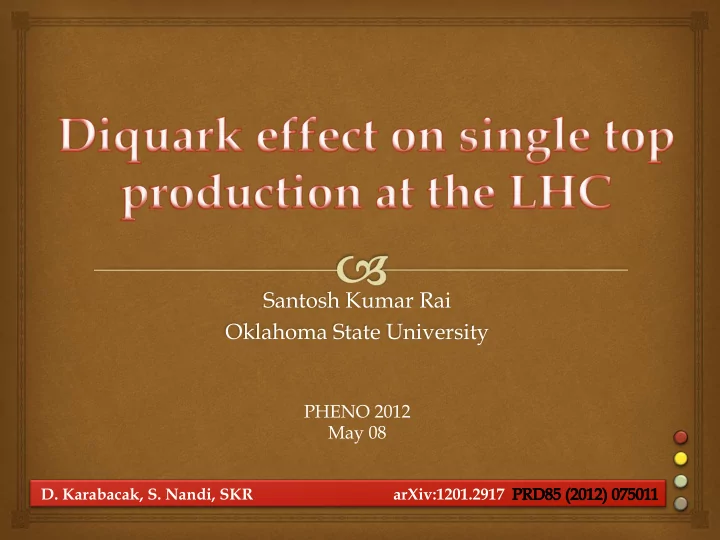

Santosh Kumar Rai Oklahoma State University PHENO 2012 May 08 D. Karabacak, S. Nandi, SKR arXiv:1201.2917
Outline � ट Single top production at LHC ट Colored resonances at LHC ट Diquark contribution to single top production ट Numerical results & Discussions ट Summary
• The heaviest fundamental particle in Standard Model decays before it can hadronize large production rate at LHC • Single production in three different channels t-channel s-channel • Measurement of the tbW vertex • Source for polarized tops
• The theoretical cross-sections at NLO+NNLL @LHC 7 TeV N. Kidonakis (2011) • The different modes are affected differently by new physics s-channel contribution will fall off with increasing mass in the final state but mode more sensitive to massive particle exchange
• LHC data is already pushing the energy frontier of BSM physics predictions. • Most sensitive to strongly interacting sector of new physics models exchanged in the s-channel R-parity violating SUSY: squarks Excited quarks in composite models (Kuhn+’84, Baur’87) Color-sextet fermions, e.g. quixes.. (Martin’92) Color-octet vector bosons (axigluons, colorons) (Frampton+’87) Color-sextet scalars, scalar diquarks,.. (Pati+’74,Mohapatra+’80) More exotics (group theory decomposition) (Han+’10)
• Resonant states contribute to the dijet production Alters the dijet differential cross section at large invariant mass Effective strong constraints on such massive resonances • CMS and ATLAS limits at 95% C.L. with 1 fb -1 data Excited quark mass > 2.99 TeV (ATLAS), 2.49 TeV (CMS) Axigluon/coloron mass > 3.32 TeV (ATLAS), 2.47 TeV (CMS) Color-octet scalar mass > 1.92 TeV (ATLAS) E 6 diquark mass > 3.52 TeV (CMS)
• Colored particles carrying quantum number of two quarks Exotic baryon number – twice that of ordinary quarks Can be a triplet or sextet of SU(3) C ( 3X3 = 3 + 6 ) Can be scalar or vector Produced through quark-quark annihilation as resonance • Dijet cross section (Cakir+’99’02’05, Beger+’10,Han+’10,Richarsdon+’11 ) Same sign top pair (Barger+’08, Frederix+’09, Berger+’10,Kosnik+’11) Single top quark production (Gogoladze+’10) We focus on the vector diquark (sextet) exchange in the s-channel for single top production The effective Lagrangian density for the vector diquark interacting with quark pair:
Note: The anti-top production is significantly suppressed with initial states ud
The diquarks also contribute to dijet cross section. We use the upper ' is unconstrained) limits on the cross section ( � 33 1107.4771 (CMS), 1108.6311 (ATLAS) We also use the upper bound on the single-top cross section in the s- channel ATLAS-CONF-2011-118 Final State: Different sub-processes contributing to the SM background
Kinematic Cuts
• With the basic selection cuts we evaluate the LO contributions to the final state within the SM using the event generator MadGraph 5. • Signal for two values of diquark mass of M D = 2(3) TeV and coupling
The transverse momenta distribution of the leading b-jet for the signal will tend to be hard and peak at around p T � M D 2 The sub-leading b-jet and charged lepton carry the boost of the top quark
The leading b-jet is well isolated from the other particles for the signal The characteristic behavior of particles coming from the decay of heavy resonance would be that they are produced back-to-back in the transverse plane and are well separated.
The sub-leading b-jet and the charged lepton (from the decay of highly boosted top) will tend to have less separation for the signal
The diquark mass acts as an upper bound for the invariant mass value for the signal
In this case the top quark mass acts as an upper bound for the invariant mass value
As there is only a single neutrino in the final state, one can in principle reconstruct the diquark mass from the final states Would be the best discriminant against the background !
Modification in rates after introducing a stronger cut on the leading b-jet p T
LHC sensitivity to the diquark mass as a function of the coupling @ 7 TeV Basic cuts After p T > 400 GeV cut
• We have considered the effects of a vector diquark resonance on the single top quark production. • We find that there could be large enhancements in the single top quark production at LHC. • Various kinematic distributions effectively capture the essence of a heavy particle exchange which distinguish it from SM background. • Use of specific selection cuts on the kinematics helps increase the LHC sensitivity to heavier diquark mass. • For the vector diquark which couples more strongly to the third generation quarks the LHC can be sensitive to higher values of the diquark mass when compared to the dijet channel.
Recommend
More recommend